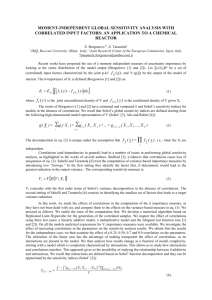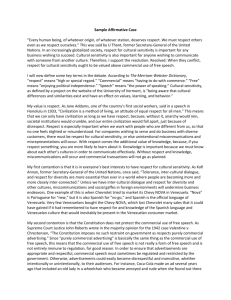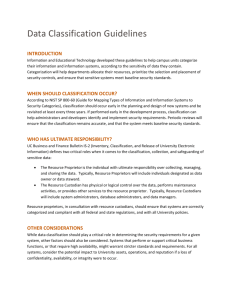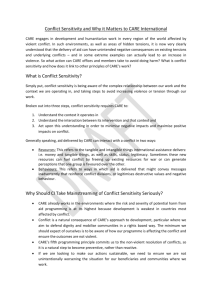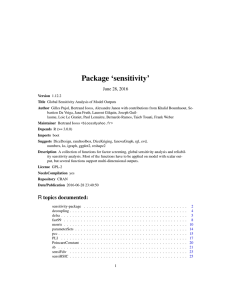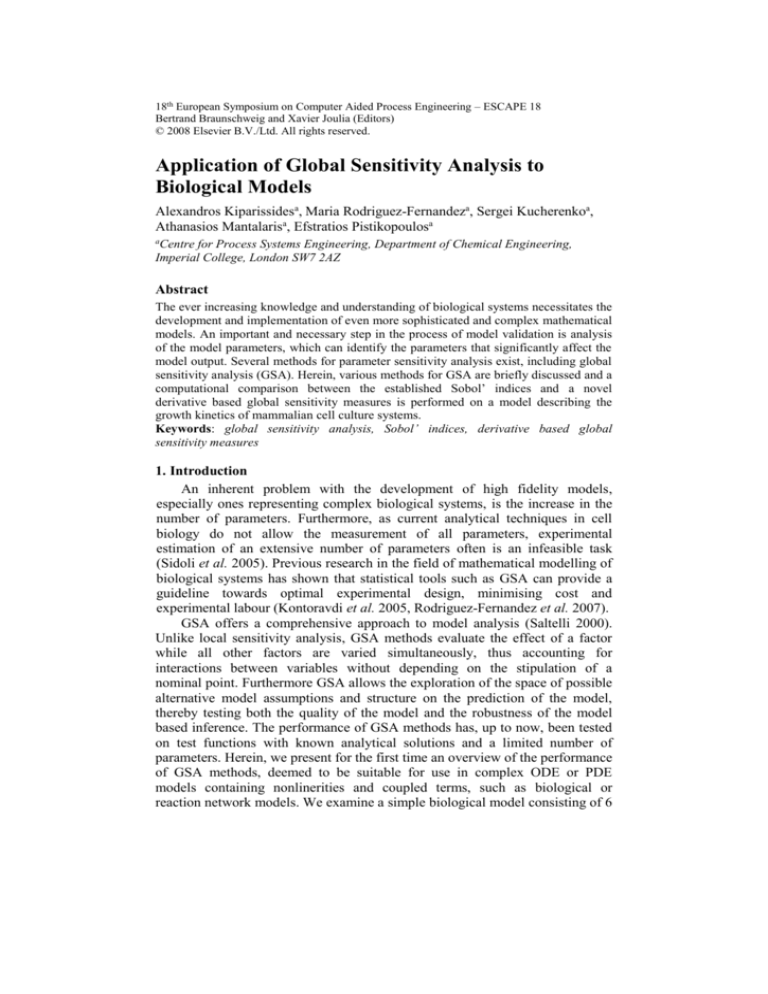
18th European Symposium on Computer Aided Process Engineering – ESCAPE 18
Bertrand Braunschweig and Xavier Joulia (Editors)
© 2008 Elsevier B.V./Ltd. All rights reserved.
Application of Global Sensitivity Analysis to
Biological Models
Alexandros Kiparissidesa, Maria Rodriguez-Fernandeza, Sergei Kucherenkoa,
Athanasios Mantalarisa, Efstratios Pistikopoulosa
a
Centre for Process Systems Engineering, Department of Chemical Engineering,
Imperial College, London SW7 2AZ
Abstract
The ever increasing knowledge and understanding of biological systems necessitates the
development and implementation of even more sophisticated and complex mathematical
models. An important and necessary step in the process of model validation is analysis
of the model parameters, which can identify the parameters that significantly affect the
model output. Several methods for parameter sensitivity analysis exist, including global
sensitivity analysis (GSA). Herein, various methods for GSA are briefly discussed and a
computational comparison between the established Sobol’ indices and a novel
derivative based global sensitivity measures is performed on a model describing the
growth kinetics of mammalian cell culture systems.
Keywords: global sensitivity analysis, Sobol’ indices, derivative based global
sensitivity measures
1. Introduction
An inherent problem with the development of high fidelity models,
especially ones representing complex biological systems, is the increase in the
number of parameters. Furthermore, as current analytical techniques in cell
biology do not allow the measurement of all parameters, experimental
estimation of an extensive number of parameters often is an infeasible task
(Sidoli et al. 2005). Previous research in the field of mathematical modelling of
biological systems has shown that statistical tools such as GSA can provide a
guideline towards optimal experimental design, minimising cost and
experimental labour (Kontoravdi et al. 2005, Rodriguez-Fernandez et al. 2007).
GSA offers a comprehensive approach to model analysis (Saltelli 2000).
Unlike local sensitivity analysis, GSA methods evaluate the effect of a factor
while all other factors are varied simultaneously, thus accounting for
interactions between variables without depending on the stipulation of a
nominal point. Furthermore GSA allows the exploration of the space of possible
alternative model assumptions and structure on the prediction of the model,
thereby testing both the quality of the model and the robustness of the model
based inference. The performance of GSA methods has, up to now, been tested
on test functions with known analytical solutions and a limited number of
parameters. Herein, we present for the first time an overview of the performance
of GSA methods, deemed to be suitable for use in complex ODE or PDE
models containing nonlinerities and coupled terms, such as biological or
reaction network models. We examine a simple biological model consisting of 6
2
A. Kiparissides et. al.
differential equations and 16 model parameters. The measured sensitivity for
the model parameters is dependant on the variable chosen to be the output
variable.
2. Global Sensitivity Analysis
The term global is used to characterise methods that posses two basic
properties (Salteli 2000): (i) all parameters are varied simultaneously and (ii)
sensitivity is measured over the entire range of each input factor. When dealing
with a nonlinear model and input factors that are affected by uncertainties of
varying magnitude, a global sensitivity approach is the more suitable option.
The most widely used methods in GSA are, FAST and extended FAST, the
Sobol’ indices and the Morris method and its adaptations.
A method developed in 1991 by Morris, classified as a screening method
provides a fast and computationally cheap method to rank parameters. Although
this method is regarded as global, it is based on the computation of local
measures (Saltelli 2000). The method covers the whole space in which the
parameters may vary, hence the term global. The ranking is based solely on the
main effect each factor has on the output variance. By averaging the local
measures over a range of points an estimate of the importance of each factor is
gained. The novel derivative based global sensitivity measures (DGSM),
developed by Kucherenko et. al.(2007) is a method conceptually based on the
Morris method, and is capable of providing information on the total effect for
each parameter while maintaining the low computational cost.
The basic concept of FAST is the decomposition of the total output
variance of the model to summands of increasing dimensionality. In order to
acquire these summands, the properties of a Furrier series transformation are
utilised. The initial method only provided first order information ignoring any
possible influence through parameter interactions. Even though the computation
of the total indices using FAST was proposed by Saltelli and Bolado (1998),
extended FAST still lacks the accuracy and transparency of the Sobol’ method.
The method of global sensitivity indices developed by Sobol’ (2001) is
based on an ANOVA type of a high dimensional model representation. It is
superior to other SA methods, such as those based on correlation or regression
coefficients because it is model-independent. In particular it works for nonlinear and non-additive models. Furthermore it allows the calculation of the
total sensitivity indices, which measure the total contribution of a single input
factor. The Sobol’ method is superior to the original FAST in that the
computation of the higher interaction terms is well defined and easy to interpret.
In the past, the Morris method was regarded as inferior to the Sobol’ and
FAST methods due to the small amount of information it provided. The DGSM
method is believed to yield valuable information since it can both provide the
order of significance with respect to the output variance of various parameters
as well as capture the relative difference in importance between two parameters.
Consequently, a comparison between the Sobol’ global indices and the novel
DGSM was examined and the quality of information obtained was compared in
Application of Global Sensitivity Analysis to Biolgical Models
3
terms of ranking of parameters, required computational time and ease of
implementation.
2.1. Global Sensitivity Methods used
A detailed description of the Sobol’ method for GSA is provided by Saltelli
(2000) and Sobol’ (2001). Considering a differentiable function f(x), where x =
{xi} is a vector of input variables defined within the unit hypercube In. Local
sensitivity measures are based on partial derivatives and are of the form:
Ei ( x*)
f ( x i ) f ( xi )
f
xi
(1)
Sensitivity measure Ei(x*) depends on a nominal point x * and its value varies
according to the value of x * . This deficiency can be overcome by averaging
Ei(x*) over the parameter space In. Such a measure can be defined as:
M i Ei dx
(2)
In
Non-monotonic functions consist of regions with both positive and negative
values of partial derivatives Ei(x*), hence due to the effect of averaging, values
of M i can be very small or even zero. To avoid such situations measures based
on the absolute value of |Ei(x*)| can be used: Another informative measure to
consider is the variance of M i which can be estimated by:
i2 n Ei2 dx M i2
I
(3)
By combining the presented measures a new measure can be derived:
Gi i2 M i2 n Ei2 dx
I
(4)
A normalised version of the new measure can be defined as:
s
n
i 1
i 1
G Gi / Gi ,
(5)
Where 1 ≤ s ≤ n. The G measure can account for the fractional significance of
a particular parameter with respect to the total variance, or for a group of
parameters with respect to the total variance.
Calculation of DGSM is based on the evaluation of integrals (2)-(5), which
can be presented in the following generic form:
I [ f ] n f ( x)dx
(6)
I
Monte Carlo algorithm can be used for the evaluation of integrals of the
general form (6). The convergence rate of MC does not depend on the number
of variables n although it is rather low. A higher rate of convergence can be
obtained by using deterministic uniformly distributed sequences also known as
low-discrepancy sequences instead of pseudo-random numbers. Methods based
on the usage of such sequences are known as QMC methods. The QMC method
4
A. Kiparissides et. al.
with Sobol' LDS sequences was used in the present work because of its high
efficiency (Kucherenko et al. 2007).
1 N
(7)
I N f (qi ).
N i 1
The total number of function evaluations required for the calculation of a full
set of {M i } and { i } is NF = N (n +1).
3. Results and Discussion
The investigation of the performance of the two proposed methods for GSA
was performed on a model consisting of 6 ODEs and 16 model parameters,
based on the model of Jang and Barford (2000) and adapted by Kontoravdi et
al. (2005). The model under consideration was initially developed for antibody
producing hybridoma cell lines, but with proper adaptation can be used for other
mammalian cell lines. The model operates under the assumption of perfect
mixing of the cell culture. It also assumes that only two of the key nutrients
namely, glucose and glutamine, are considered as growth limiting factors, while
their products, lactate and ammonia respectively, are the only inhibitors. The
model utilises Michaelis-Menten type kinetics to describe the rate of nutrient
uptake and product formation. In the present study the model was operated
under batch conditions. All simulations were performed on an Intel Pentium®
(D) (CPU 2.80GHz, 2.79GHz) personal computer with 1 Gigabyte of R.A.M.
memory. Both the model and the sensitivity analysis were implemented with the
use of Matlab® mathematical suite. A stiff stable ODE solver was utilised to
perform the necessary model evaluations, namely routine ode15s.
The simulations involved the scanning of all model parameters with respect
to each of the six possible model output variables. Sensitivity Analysis was
performed at 10 hour intervals from the beginning of the culture, until the
termination of the culture. Batch processes that involve the secretion of
biologically active molecules usually are not left to proceed until completion.
Due to the accumulation of toxic products within the bioreactor which threaten
to degrade valuable end products and render them biologically inactive, it is
common practice for the batch culture to be terminated when the cell viability
falls below 50% of the total cell concentration. For the current model, this is
observed to occur at 150 h after the initialisation of the culture. Parameters were
varied by ± 50% of their nominal value.
A meaningful comparison that highlights difference between the two methods,
is computational time. While the DGSM method required 2.7e4 sec of
computational time, the calculation of the Sobol’ global sensitivity indices
required 6.3e5 sec. More importantly when examining the results these methods
yield, it was observed that the DGSM performs in a quite similar way as the
Sobol’ method. In Figures 1-6, the sensitivity indices for all 16 parameters are
presented for 3 time points and 2 possible output variables. The time points
were chosen to represent the important phases of a batch cell culture process.
The first of the chosen time points corresponds to the initiation of the growth
Application of Global Sensitivity Analysis to Biolgical Models
5
phase, which occurs subsequently to the lag phase, around 20 h into the culture.
The second time point is at the end of the exponential growth phase, where the
concentration of viable cells obtains its maximal value, and the last time point is
in the middle of the death phase towards the end of the culture.
Figures 1-6: Calculated sensitivity indices for various time points and two different output
variables; F1-F3: Sensitivity indices for viable cell concentration at time points 20h, 50h and
100h. F4-F6: Sensitivity indices for glucose concentration at time points 20h, 50h and 100h.
Model parameters: 1:μmax ; 2:kglc ; 3:kgln ; 4:KIlac ; 5:KIamm ; 6:μd,max ; 7:kd,gln ; 8:kd,amm ; 9:Ylac,glc ;
10:n ; 11:mglc ; 12:Yx,gln ; 13:Yx,glc ; 14:Yamm,gln ; 15:a1 ; 16:a2.
Both methods are in good agreement in the top ranking parameters, not only
in terms of identification but also in terms of relative significance towards the
less important parameters. Differences do occur in the ranking of the least
significant parameters; however this is insignificant since the indices for these
parameters are rather small. As the culture exits the growth phase and enters the
death phase, the most significant parameters are bound to change, as different
6
A. Kiparissides et. al.
mechanisms govern the culture. This transition is successfully captured by both
methods. Overall both methods yield the same results; hence the DGSM method
appears to be more advantageous due to its significantly lower computational
requirements. However it is noteworthy mentioning that the choice of Δ needs
to be made with caution and is problem dependant. In fact, for the current
problem, a Δ value of 10-5 was used for the calculation of the indices with
respect to glucose concentration, while for the viable cell concentration the
value used was 10-3. It is obvious that the resulting indices depend on the choice
of Δ, which should be looked into before performing the actual analysis.
4. Conclusions
The DGSM method appears to be a more desirable method for GSA of
biological models, especially complex ones, since it combines the quality of
information provided by the established Sobol’ indices with far lower
computational requirements. Since the presented difference in computational
time was for a minimal biological model the advantage in computational time
could prove critical when analysing very complex models. It is imperative, that
a comparison of the performance of the two methods in larger scale models,
such as the model presented in the work of Kontoravdi et al.(2004) is
performed, as well as an investigation for a consistent choice of the value of Δ.
Acknowledgements
Alexandros Kiparissides would like to gratefully acknowledge financial support from
the PROBACTYS E.U. project. S.Kucherenko and M. Rodriguez-Fernandez would like
to acknowledge the financial support by the EPSRC grant EP/D506743/1.
References
J.D. Jang, J.P. Barford, 2000, An unstructured Kinetic Model of Macromolecular metabolism in
batch and fed-batch cultures of hybridoma cells producing monoclonal antibody, Biochem.
Eng. J., 4, 153-168.
C. Kontoravdi, S.P. Asprey, E.N. Pistikopoulos and A. Mantalaris, 2004, Development of a
dynamic model of monoclonal antibody production and glycosylation for product quality
monitoring, Comp. and Chem. Eng., 31, 392-400.
C. Kontoravdi, S.P. Asprey, E.N. Pistikopoulos and A. Mantalaris, 2005, Application of Global
Sensitivity Analysis to determine goals for design of experiments: An example study on
Antibody-Producing cell cultures, Biothechnol. Prog., 21, 1128-1135.
S. Kucherenko, M. Rodriguez-Fernandez, C. Pantelides, N. Shah, 2007, Monte Carlo evaluation
of Derivative based Global Sensitivity Indices, submitted to Reliab, Eng. Syst. Safety, 2007
M. Rodriguez-Fernandez, S. Kucherenko, C. Pantelides, N. Shah, 2007, Optimal experimental
design based on global sensitivity analysis. Computer-Aided Chemical Engineering, vol.24
Proceedings European Symposium on Computer Aided Process Engineering, (ESCAPE17,
2007), 63.
A. Saltelli, K. Chan, E.M. Scott, 2000, Sensitivity Analysis, Wiley Press.
Saltelli A., Bolado R.,1998, An alternative way to compute Fourier amplitude sensitivity test
(FAST), Computational Statistics & Data Analysis 26 , 445-460.
Sidoli F.R., Mantalaris A., Asprey S.P.,2005, Toward Global Parametric Estimability of a LargeScale Kinetic Single-Cell Model for Mammalian Cell Culture,
Ind. Eng. Chem. Res., 44
(4), 868 -878.
I. Sobol’, 2001, Global Sensitivity Indices for nonlinear mathematical models and their Monte
Carlo estimates, Math. and Comp. in Sim., 47, 103-112.


